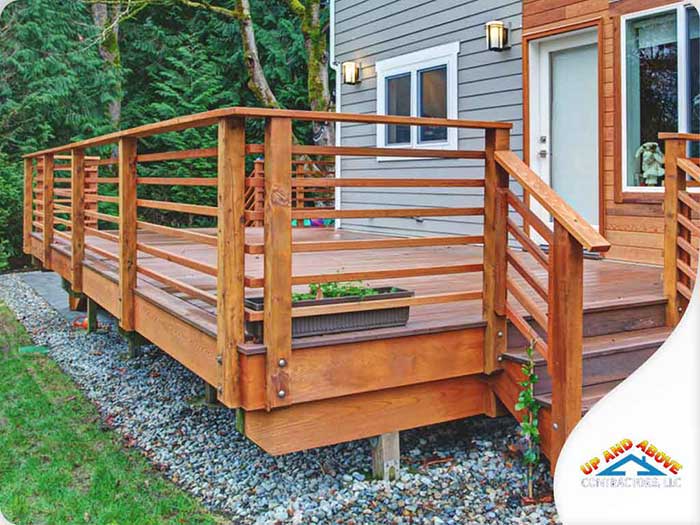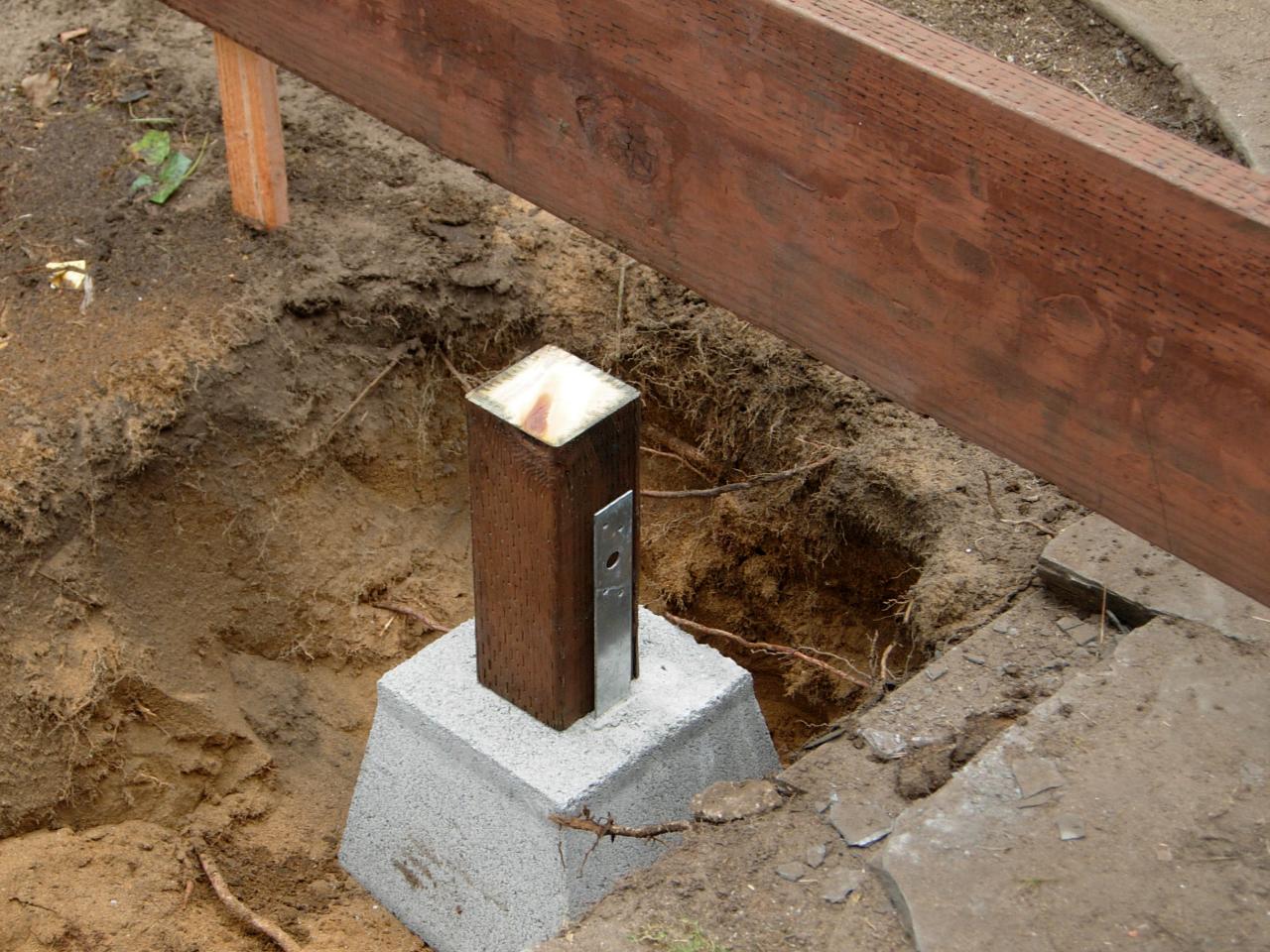Choosing the Right Deck Footings for Stability and Toughness
The longevity and security of your deck depend greatly on the type of footings you choose, as they offer the vital support and security to hold up against the examination of time. In this discussion, we will discover the different types of deck footings, think about the important variables to consider when making a choice, and dive into the pros and cons of different options.
Sorts Of Deck Grounds
There are a number of types of deck grounds that can be utilized, each offering one-of-a-kind benefits and factors to consider. One typical sort of footing is the concrete pier footing. These grounds include a round hole loaded with concrete, which provides a solid structure for the deck posts. Concrete pier footings are reasonably very easy to set up and provide excellent stability, making them a popular choice for numerous deck jobs.
One more kind of footing is the helical heap ground. Helical piles are steel shafts with helical plates affixed to them. These grounds are mounted by screwing them right into the ground, which develops a protected structure for the deck. Helical pile footings are optimal for areas with challenging soil conditions, as they can be mounted in almost any kind of soil. If needed., they also allow for easy adjustment and progressing of the deck.
Conversely, some building contractors choose precast concrete footings. These grounds are made from resilient concrete and can be found in different shapes and sizes to accommodate different deck styles. Precast concrete grounds are hassle-free to set up and offer a steady base for the deck framework.
Lastly, an additional option is the post-in-anchor footing system. This kind of ground entails driving a steel support right into the ground and affixing it to the deck post. It supplies flexibility in terms of positioning the deck posts and appropriates for decks with light-weight frameworks.
When selecting the appropriate kind of deck ground, it is important to consider aspects such as dirt problems, deck load, and regional structure codes (Deck Footings). Consulting with a professional service provider or structural engineer can help guarantee the suitable ground is selected for a safe and stable deck
Elements to Consider When Selecting Footings
When choosing the ideal grounds for a deck, it is vital to very carefully take into consideration various elements such as dirt problems, deck lots, and adherence to neighborhood structure codes. These variables play a substantial function in making certain the stability and toughness of the deck framework.
One of the main aspects to think about is the soil conditions. The sort of soil on which the deck will be constructed determines the kind of footings required. Decks constructed on loosened or sandy dirts may need deeper footings to provide sufficient assistance and prevent settling. On the various other hand, decks developed on clay or large soils might need grounds that can suit the soil's tendency to increase and contract.
An additional crucial element is the deck lots. The weight of the deck, including the materials used and any kind of prospective live lots such as furnishings or celebrations, have to be taken into consideration when picking grounds. The footings must be created to bear the weight of the deck and distribute it equally to stop any kind of architectural issues or failings.
Last but not least, adherence to local building codes is vital. Structure codes vary from region to region, and it is vital to adhere to the specific requirements set by the regional authorities. Deck Footings. These codes make certain that the deck is built safely and satisfies the needed criteria for structural integrity and load-bearing capacity
Concrete Footings: Pros and Cons

Concrete grounds use several advantages and disadvantages when used as the structure for a deck. On the favorable side, concrete grounds provide outstanding security and sturdiness. Concrete is a strong and rigid product that can support heavy loads and stand up to various weather. It also has a long lifespan, making it a reputable choice for lasting usage.
One more benefit of concrete grounds is their convenience. They can be poured into different shapes and sizes to suit different deck layouts and arrangements. Concrete footings can be tailored to fit the specific requirements and demands of the deck structure.
Nevertheless, there are additionally some disadvantages to using concrete footings. One significant negative aspect is the expense and labor included in their installation. Concrete grounds require excavation and commonly require the aid of hefty machinery. This can increase the general expense of the deck project and might need professional assistance.

Helical Piers Vs. Sonotubes: Which Is Much better?
In considering the foundation choices for a deck, the comparison between helical piers and sonotubes is critical in identifying the superior selection. Helical piers, additionally called screw piles, are steel shafts with helical plates affixed to them. They are twisted right into the ground making use of hydraulic equipment, supplying a sturdy and stable structure for the deck. On the various other hand, sonotubes are round types made of cardboard or fiber product that are full of concrete. They are positioned in a hole dug into the ground and give support for the deck.
When it pertains to security and longevity, helical piers have the top hand. The helical plates on the piers develop a solid hold with the dirt, moving or protecting against any type of motion of the deck. This is specifically advantageous in areas with unstable or shifting soil conditions. Sonotubes, on the other hand, count solely on the concrete filling click resources for security, which might not supply the same degree of strength and resistance.
In terms of setup, helical piers are reasonably easier and you can look here faster to install compared to sonotubes. The hydraulic machinery used to turn the piers into the ground guarantees a quick and effective process. Sonotubes, on the various other hand, need excavating openings and pouring concrete, which can be time-consuming and labor-intensive.
Additionally, helical piers are an even more flexible alternative. They can be used in various dirt conditions and can be adjusted or reinforced if needed. Sonotubes, on the various other hand, may require added support, such as rebar, in certain dirt conditions or locations with high lots demands.
Picking the Right Footings for Your Deck's Dimensions
For optimum structural integrity, it is vital to carefully choose the proper footings that straighten with the measurements of your deck. The dimensions of your deck, including its size, height, and size, play a significant duty in figuring out the kind and dimension of footings needed.
When choosing grounds for your deck, it is essential to consider the load-bearing capacity of the dirt. The weight of the deck, incorporated with the weight of any kind of furniture or people on it, applies a significant force on the footings (Deck Footings). For that reason, it is view it critical to select grounds that can appropriately support this weight without sinking or shifting in time.
The dimension and form of the footings should also be thought about. Larger decks with greater measurements need larger grounds to give adequate stability and support. The form of the footings, whether they are square or rounded, depends upon the design and layout of the deck. In addition, the depth at which the footings are mounted ought to be determined based upon the frost line in your region to avoid any kind of heaving or moving due to freezing temperature levels.
Conclusion
In verdict, picking the right deck footings is critical for ensuring stability and toughness. Variables such as the type of footings, the deck's dimensions, and the pros and cons of different choices must be taken into consideration.
These grounds are composed of a cylindrical opening filled with concrete, which offers a solid foundation for the deck articles. Concrete pier grounds are relatively simple to set up and supply excellent stability, making them a popular choice for lots of deck tasks.
Precast concrete grounds are hassle-free to mount and give a secure base for the deck framework.
It supplies flexibility in terms of positioning the deck posts and is suitable for decks with light-weight frameworks.
Concrete grounds use numerous benefits and downsides when utilized as the foundation for a deck.